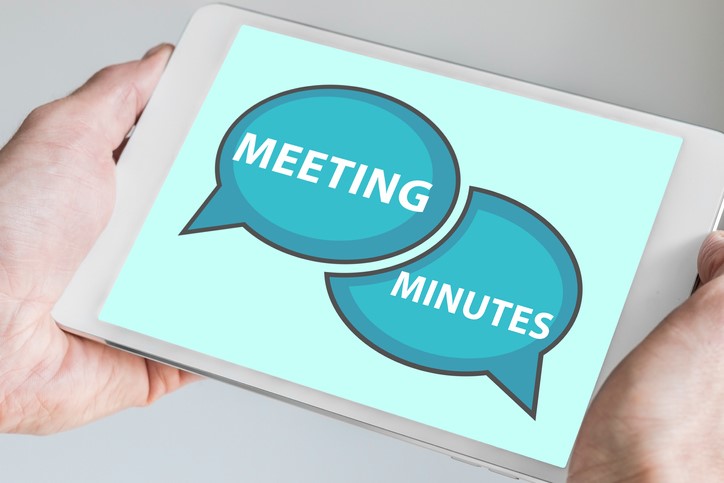When taking minutes for a public board meeting, including certain details is essential. The minutes, after all, become a legal record of the meeting. At the same time, not every detail should be written down; minutes are not a verbatim transcript. Some boards prefer minutes that summarize only the actions taken on each business item, excluding a summary of the discussion. Others like more comprehensive minutes that include an overview of deliberations. Following a template directs a recording secretary to listen for the precise information he should put in writing during the meeting. For minutes that include discussion summaries, following this template generates the best possible minutes with the least possible anxiety.
Name of Committee
Day and Date
Time
Location
- Statement of Compliance with ADA and Open Meeting Laws (asserting that a quorum was present and deliberations did not take place before the meeting.)
- Statement acknowledging if the meeting was audio- or video-recorded and, if so, by whom.
Minutes
PRESENT: Full titles, first names and last names (not nicknames) of all those who attended meeting
REGRETS: First and last names of committee members who contacted the chairperson to let them know they would be unable to attend
ABSENT: First and last names of committee members who did not attend but did not contact the chairperson to let them know
GUESTS: First and last names of invited guests
- CALL TO ORDER
- Time that the chairperson called the meeting to order
- Summary of any opening comments that the chairperson made
- APPROVAL OF THE MINUTES FROM (DATE) [Note: You need a motion to approve the previous meeting’s minutes or a motion to accept the minutes as amended, if any changes were made.]
Acknowledge here that meeting minutes were pre-distributed to voting members.
Motion: To approve the minutes of (DATE) as (DISTRIBUTED or AMENDED)
Motion by: Name of person who made the motion (FIRST and LAST)
Seconded by: Name of the person who seconded the motion (FIRST and LAST)
Carried or Defeated
- APPROVAL OF COMMITTEE REPORTS
Acknowledge here that committee reports were pre-distributed to voting members.
Motion: To approve the __________ Committee Report, the _____________Committee Report and the ____________ Committee Report, (as submitted) OR (as amended)
Motion by: Name of person who made the motion (FIRST and LAST)
Seconded by: Name of person who seconded the motion (FIRST and LAST)
Carried or Defeated
- BUSINESS ITEM #1
- Put a summary of the discussion on the topic here.
- If a motion was made, put here the name of the person who made the motion and the exact wording of the motion. [This may mean asking for a repeated statement of the motion, either during or after the meeting.]
- If the motion needs expert testimony or further committee research, put that information here.
- If the motion was called to a vote, put here the outcome of the vote.
- You may (and, in some states, must put the vote tally here – e.g., “The motion was carried by a vote of 5 to 2.”)
- You may (and, in some states, must list the vote of each voting member by name – e.g., “Votes in favor: Ghazi, Kamtekar, Ramirez, Smith, Lafayette. Votes against: Imel, Buonanno”)
- Tasks. For each duty, put the name of the person(s) responsible and the deadline.
- BUSINESS ITEM #2
- Put a summary of the discussion on the topic here.
- If a motion was made, put here the name of the person who made the motion and the exact wording of the motion. [This may mean asking for a repeated statement of the motion, either during or after the meeting.]
- If the motion needs expert testimony or further committee research, put that information here.
- If the motion was called to a vote, put here the outcome of the vote.
- You may (and, in some states, must put the vote tally here – e.g., “The motion was carried by a vote of 5 to 2.”)
- You may (and, in some states, must list the vote of each voting member by name – e.g., “Votes in favor: Ghazi, Kamtekar, Ramirez, Smith, Lafayette. Votes against: Imel, Buonanno”)
- Tasks. For each duty, put the name of the person(s) responsible and the deadline.
- CLOSED SESSION
- Referencing (even quoting) relevant state open meeting requirements for closed-session meetings, state reason closed session was called (typically personnel deliberations or strategy sessions for litigation or bargaining). Indicate time closed session began and ended. Note if an attorney or other invited participant attended the closed session.
- BUSINESS ITEM #3
- Put a summary of the discussion on the topic here.
- If a motion was made, put here the name of the person who made the motion and the exact wording of the motion. [This may mean asking for a repeated statement of the motion, either during or after the meeting.]
- If the motion needs expert testimony or further committee research, put that information here.
- If the motion was called to a vote, put here the outcome of the vote.
- You may (and, in some states, must put the vote tally here – e.g., “The motion was carried by a vote of 5 to 2.”)
- You may (and, in some states, must list the vote of each voting member by name – e.g., “Votes in favor: Ghazi, Kamtekar, Ramirez, Smith, Lafayette. Votes against: Imel, Buonanno”)
- Tasks. For each duty, put the name of the person responsible and the deadline.
- PUBLIC REMARKS
NAME of first speaker. TOPIC of first speaker. Put summary of first speaker’s remarks here.
NAME of second speaker. TOPIC of second speaker. Put summary of second speaker’s remarks here.
NAME of third speaker. TOPIC of second speaker. Put summary of third speaker’s remarks here.
- ADJOURNMENT. (Record the time the chairperson adjourned the meeting.)
- NEXT MEETING (Put date, time, and location of next meeting here.)





